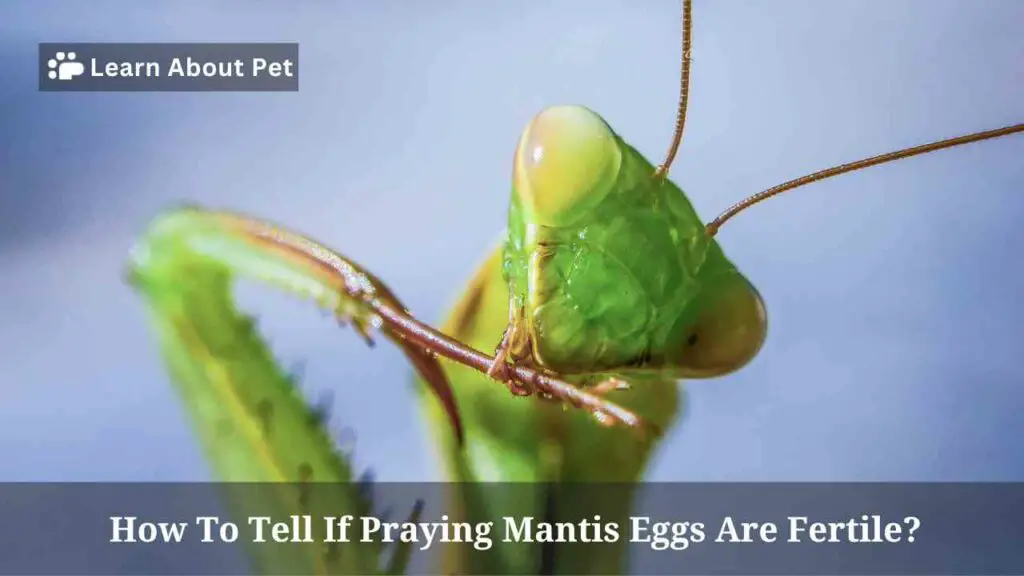The praying mantis is a popular predatory insect that is often found in wild habitats with green vegetation or home gardens. If you find a female praying mantis that has finished mating and laying eggs, you can see what praying mantis egg cases look like.
Praying mantis will collect their eggs in smooth nests or ootheca. An ootheca will protect the eggs until they finally hatch.
How to tell if praying mantis eggs are fertile? There is no specific way to tell if praying mantis eggs are fertile. The ootheca takes about four weeks to hatch. If you are curious whether your ootheca is fertile or not, slice the top of the ootheca. Don’t slice it off completely, just a little bit to see any liquid ooze come out. Liquid ooze is a sign of fertility.
Otherwise, when the ootheca is dry, hard or just black, the ootheca will more than likely be infertile.

People still don’t know about praying mantis egg cases or ootheca. Read till the end to learn about praying mantis eggs.
How To Tell If Praying Mantis Eggs Are Fertile?
How do I know if my praying mantis ootheca is fertile? There is no specific way to understand whether a mantis egg is fertile. Mantis do not lay single eggs, but they lay a hundred or more at a time and are placed in a smooth nest that we call the ootheca.
Wait four weeks until the eggs hatch. If the praying mantis egg sack not hatching even though it has been more than four weeks, then it is likely that the egg is infertile.
Will A Praying Mantis Lay Unfertilized Eggs?
Yes. Female praying mantis will lay ootheca after mating or when mantis are not doing so. If the female is not mating, her ootheca will be infertile, and they lay unfertilized eggs.
Mating will provide the female praying mantis the fertilized eggs possibility, although there is still a chance that the female mantis rejects the male spermatophore.
How Can You Tell If A Praying Mantis Egg Hatched?
You must ensure that the praying mantis has reached the hatch time of between 42-56 days. If you start to see sawdust hanging right at the top of the ootheca, that means the nymph is starting to come out of its enclosure.
It’s impossible to tell whether the ootheca has been hatched unless you can look for tiny nymphs around or see the narrow opening in the eggshell.
Can I Move A Praying Mantis Egg Sack?
Yes, you can relocate the praying mantis egg sack to a safer place or another part of your garden. Put the egg case onto another stem or put it in a hanging place about a foot or two off the ground.
Never put the ootheca on the ground, because ants can eat praying mantis eggs in the ground.
How Long After A Praying Mantis Lays Eggs Do They Hatch?
You can expect between 4-6 weeks to hatch. Transfer the egg sack to a plastic jar with air holes to ensure the temperature is suitable until hatching time.
Some praying mantis ootheca do not hatch because they are found late in winter, and outdoor temperatures make the babies die inside due to freezing.
The average time for praying mantis eggs to hatch is 42 to 56 days. Mantis eggs can hatch at a time of day or night. The right temperature for hatches is 65-75°F daytime and 45° at night.
How Many Babies Hatch From A Praying Mantis Egg?
The number of babies in the ootheca depends on the praying mantis species. It is possible that 25-200 live nymphs can hatch from a single egg case. Only one-fifth of the nymphs survive until adulthood.
You can increase the percentage, if you can ensure the egg sacs’ protection from predators or natural disturbances.
How To Tell If A Mantis Egg Is Fertile?
Breeding praying mantises is complicated because we cannot know whether praying mantis eggs are fertile or infertile. The only way that is risky when you want to check that the egg sacs are fertile is to slice a little at the top of the ootheca.
If there is liquid ooze coming out of the egg sacs, that’s a possibility for praying mantis eggs to be fertile. The infertile mantis eggs will be dry and black.
To ensure you have well-protected egg sacs, the table below are tips for caring for the ootheca after praying mantis lay their eggs.
| Caring for praying mantis egg sacks | Explanation |
| Put it in a safe place | Relocate the egg sack to a jar with air holes, or clip the egg sack in a twig and put it in a safer place at a distance of 1 to 2 feet off the ground. |
| Keep at the right temperature | The right temperature for mantis egg sack is 60-80°F. |
| Keep air humidity high | Put the substrate at the bottom of the container. A good substrate is paper, cloth, small pebbles, or white sand. |
Final Verdict
You can’t tell praying mantis eggs are fertile just from the outside. Wait until the mantis eggs hatch, about 4 weeks, or slice a little of the top of the ootheca to determine whether liquid ooze comes out or not.
The only possibility for mantis eggs to be fertile is from their liquid ooze. Dry and black eggs are signs of infertile praying mantis eggs.

Welcome to Learn About Pet. My name is Rajkumar Ravichandran and I love all pets, travel, and amazing food. I write about my passion and personal experience caring for multiple pets in this blog! ❤️
Post Disclaimer
DISCLAIMER: THIS BLOG OR WEBSITE, "Learn About Pet", DOES NOT PROVIDE YOU WITH MEDICAL ADVICE AND IS NOT A SUBSTITUTE FOR MEDICAL ADVICE. ALWAYS GET IN TOUCH WITH YOUR PERSONAL VETERINARIAN AND USE INFORMATION HERE AS GENERAL ADVICE.
The information, including but not limited to, text, graphics, images and other material contained on this website are for informational purposes only. No material on this site is intended to be a substitute for professional veterinary advice, food recommendation, diagnosis, or treatment. Always seek the advice of your veterinarian or other qualified health care provider with any questions you may have regarding a medical condition or for pet food related questions.







